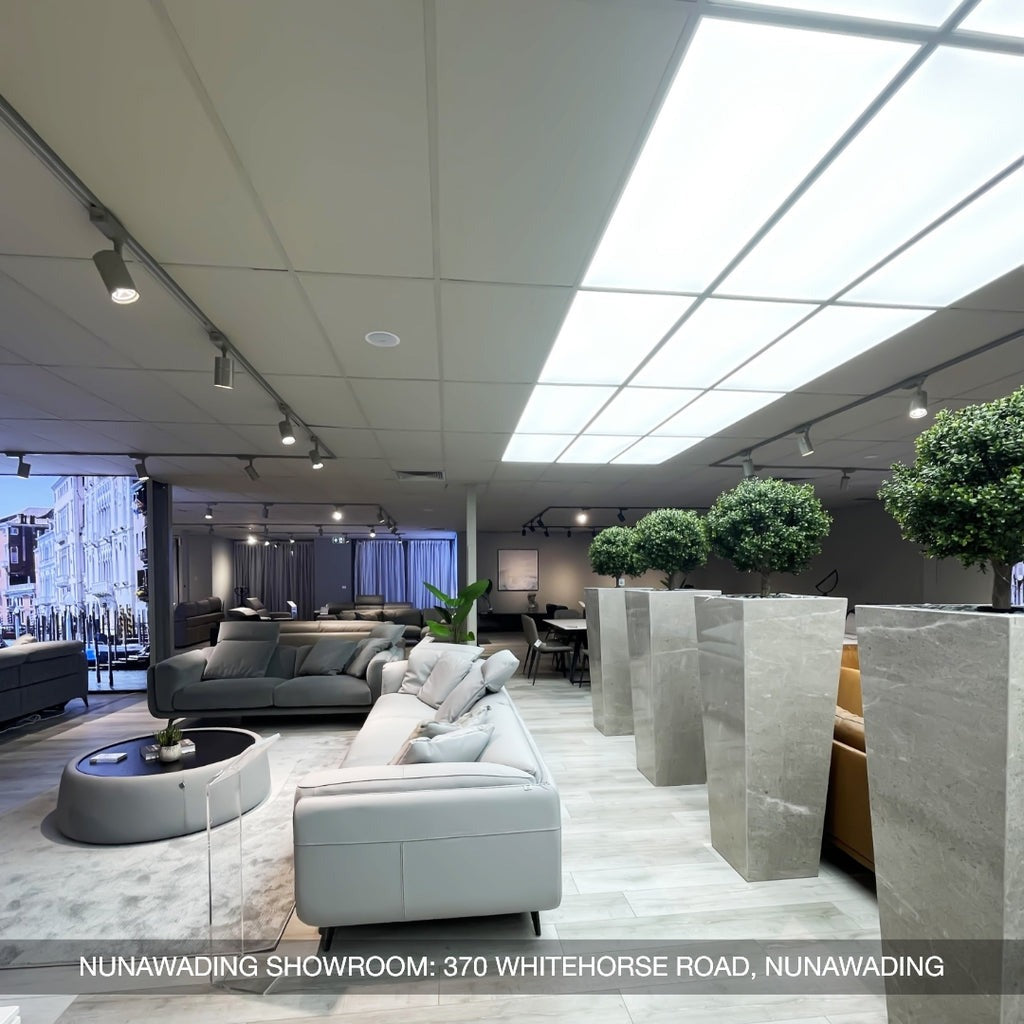Nubuck leather sofas have gained significant popularity in recent years due to their unique texture and luxurious appeal. As a variant of traditional leather, nubuck possesses a velvety surface, achieved through sanding the top grain of hide. This process enhances its softness and creates a subtle, sophisticated look. While nubuck exudes elegance, it's essential to delve into its pros and cons to make an informed purchasing decision.
In this exploration, we will discuss the advantages and drawbacks of nubuck leather sofas, along with the frequently asked question: "Is nubuck better than leather?" Understanding these aspects will enable you to appreciate the charm and practicality of nubuck leather sofas in your home.
What Is A Nubuck Leather Sofa?
Nubuck leather, historically sourced from deer, moose, or elk buckskin, is now often made from calves, sheep, or goats due to their abundance. Being a top-grain material, it originates from the tough outer layer of the hide, ensuring high-quality. Through sanding, nubuck acquires its distinctive velvet-like finish, which adds character but may leave imperfections.

The sanding process grants nubuck its signature velvet-like finish, adding an alluring character to the leather, albeit with occasional imperfections.
However, these flaws can be hidden by dyeing or staining the leather to any desired color. Renowned for its luxury appeal and soft texture, nubuck requires significant upkeep to maintain its beauty over time. While it lacks the ability to develop a natural patina, its elegance remains a captivating choice for discerning consumers. For more insights, check out nubuck leather sofa reviews.
Quality
Nubuck leather sofas are a testament to exceptional quality, as they are crafted from the top-grain layer of the leather hide. This choice of material ensures unparalleled durability and longevity, making nubuck sofas a long-lasting investment for your living space.
Appearance
The appearance of nubuck leather sofas is simply captivating. The sanding process that nubuck undergoes creates a luxurious velvet-like finish, giving the sofas a distinctive and elegant look. This unique texture adds a touch of sophistication to any room and sets nubuck sofas apart from traditional leather options.
What Are The Pros & Cons of Nubuck Leather?
Pros
- The softness of nubuck leather sets it apart, offering unparalleled comfort and a luxurious feel, making it akin to velvet in its appeal.
- Its popularity in the fashion industry is well-earned, as nubuck boasts a stunning and aesthetically pleasing appearance.
- Nubuck requires low maintenance compared to other leathers, often just needing a quick brush to restore its pristine condition.
- As a quality leather, nubuck is durable, ensuring your accessories will have a long-lasting life due to its top-grain composition.
- Nubuck's breathability is a significant advantage, reducing moisture, bacteria, and mold concerns, much like genuine leather.
Cons
- Nubuck's premium quality comes at a cost, as it tends to be relatively expensive compared to other materials.
- The susceptibility of nubuck to scratches, moisture, dirt, and oil stains necessitates careful handling and maintenance.
- Unlike many other leathers that develop a desirable patina over time, nubuck does not age in the same way, which may be seen as a drawback for some leather enthusiasts.
Pros
- The softness of nubuck leather sets it apart, offering unparalleled comfort and a luxurious feel, making it akin to velvet in its appeal.
- Its popularity in the fashion industry is well-earned, as nubuck boasts a stunning and aesthetically pleasing appearance.
- Nubuck requires low maintenance compared to other leathers, often just needing a quick brush to restore its pristine condition.
- As a quality leather, nubuck is durable, ensuring your accessories will have a long-lasting life due to its top-grain composition.
- Nubuck's breathability is a significant advantage, reducing moisture, bacteria, and mold concerns, much like genuine leather.
Cons
- Nubuck's premium quality comes at a cost, as it tends to be relatively expensive compared to other materials.
- The susceptibility of nubuck to scratches, moisture, dirt, and oil stains necessitates careful handling and maintenance.
- Unlike many other leathers that develop a desirable patina over time, nubuck does not age in the same way, which may be seen as a drawback for some leather enthusiasts.
- The softness of nubuck leather sets it apart, offering unparalleled comfort and a luxurious feel, making it akin to velvet in its appeal.
- Its popularity in the fashion industry is well-earned, as nubuck boasts a stunning and aesthetically pleasing appearance.
- Nubuck requires low maintenance compared to other leathers, often just needing a quick brush to restore its pristine condition.
- As a quality leather, nubuck is durable, ensuring your accessories will have a long-lasting life due to its top-grain composition.
- Nubuck's breathability is a significant advantage, reducing moisture, bacteria, and mold concerns, much like genuine leather.
Cons
- Nubuck's premium quality comes at a cost, as it tends to be relatively expensive compared to other materials.
- The susceptibility of nubuck to scratches, moisture, dirt, and oil stains necessitates careful handling and maintenance.
- Unlike many other leathers that develop a desirable patina over time, nubuck does not age in the same way, which may be seen as a drawback for some leather enthusiasts.
- Nubuck's premium quality comes at a cost, as it tends to be relatively expensive compared to other materials.
- The susceptibility of nubuck to scratches, moisture, dirt, and oil stains necessitates careful handling and maintenance.
- Unlike many other leathers that develop a desirable patina over time, nubuck does not age in the same way, which may be seen as a drawback for some leather enthusiasts.
In conclusion, nubuck leather offers remarkable softness, beauty, and breathability, making it a sought-after material in the fashion industry. While it requires proper care to maintain its appearance, its durability and comfort make it a worthwhile investment for those who appreciate its unique qualities.
What Is The Difference Between Nubuck and PU Leather and Suede?
|
Compared to PU Leather |
Compared to Suede |
|
|
Resistance |
PU leather exhibits higher resistance to moisture and tearing than nubuck due to its plastic-based composition. However, its overall durability is compromised by the lower quality of the product, making it less long-lasting. |
Nubuck leather prevails in strength due to its production on the grain side, the toughest part of the hide, while suede is made on the flesh side, making it less durable in comparison. Nubuck is often crafted from higher quality leather than suede, contributing to its enhanced resilience. |
|
Durability |
PU leather lacks the durability of nubuck and genuine leather, and it will not age or develop a patina as natural leathers do. |
Nubuck outshines suede in durability for the same reasons, although neither leather is sought after for developing a patina over time. |
|
Feel |
Nubuck's softness surpasses that of PU leather, which tends to have an artificial, imitation leather feel. |
Both leathers offer a comparable soft and velvety feel, which adds to their luxurious appeal. |
|
Flexibility |
While PU leather is relatively flexible due to its plastic nature, it may not match the suppleness of genuine leathers like nubuck. |
Both nubuck and suede are highly flexible, with the flexibility influenced more by the type of hide used or the age of the product. |
|
Breathability |
Unlike natural leather, PU leather is non-porous and poorly breathable, which can lead to discomfort during prolonged use. |
Nubuck, having undergone a lighter sanding process than other suede leathers, exhibits better breathability, although both leathers are generally breathable. |
|
Care |
The advantage of PU leather lies in its ease of maintenance, which may even surpass that of nubuck. |
Both nubuck and suede are easy to care for, and you can find a variety of care products available for both types, except for the brush which is specifically designed for suede. |
|
Price |
As PU leather is not genuine leather, it comes at a significantly lower price point than nubuck or any natural leather. |
Nubuck is typically more expensive than suede in the majority of cases. If you come across remarkably low-priced nubuck, exercise caution as it might be counterfeit or of poor quality. Genuine nubuck leather commands a higher price due to its superior attributes. |
How To Clean, Care and Protect Nubuck Leather Sofa
Taking proper care of your nubuck leather sofa is essential to maintain its softness, beauty, and longevity. Cleaning, caring, and protecting nubuck leather can be simple with the right techniques. Here are some valuable tips to ensure your nubuck leather sofa remains in pristine condition:
Regular Cleaning: To clean leather furniture such as nubuck leather, start by using a soft brush or a microfiber cloth to gently remove surface dust and dirt. Avoid using water or harsh cleaning agents, as they can damage the delicate texture.

Opt for nubuck-specific cleaning products to maintain the integrity of the leather.
Treating Stains: If your nubuck sofa encounters spills or stains, address them promptly. Use a nubuck-specific cleaner or a dedicated nubuck eraser to gently rub away the stain. Always perform a spot test in an inconspicuous area before applying any cleaner to the entire surface.
Conditioning: Nubuck leather requires conditioning to maintain its softness and prevent it from drying out. Choose a nubuck conditioner or spray, following the manufacturer's instructions, and apply it evenly to the surface.
Protective Measures: Shield your nubuck leather sofa from potential damage by keeping it away from direct sunlight, heat sources, and sharp objects. Placing it in a well-ventilated area can also help preserve its quality.
Avoid Moisture: Nubuck leather is susceptible to moisture, so it's crucial to protect it from spills and excessive humidity. If the sofa does get wet, blot the area gently with a dry cloth and allow it to air dry naturally.

Combined with regular care and maintenance, ensures your nubuck leather furniture remains a timeless centerpiece in your living space, providing both elegance and comfort for many years to come.
Professional Cleaning: Periodically, consider seeking professional cleaning services for your nubuck leather furniture. Professionals can expertly handle tough stains and restore the sofa's appearance to its original beauty.
FAQs
Is Nubuck Leather Waterproof?
Is Nubuck Leather Waterproof?
Nubuck leather is not waterproof. Unlike some types of leather that have been treated to be water-resistant or waterproof, nubuck leather is not naturally equipped with such properties. Nubuck leather is made by sanding the top grain of leather, which creates a soft and velvety surface. However, this sanding process opens up the pores of the leather, making it more susceptible to water and moisture.
How Do You Condition Nubuck Leather?
Conditioning nubuck leather is vital to preserve its plush texture and extend its lifespan. Begin by ensuring the leather is free from surface dirt or stains. Select a high-quality nubuck leather conditioner designed specifically for this delicate material. Perform a spot test before applying the conditioner to the entire surface.
Apply a small amount of conditioner onto a soft cloth and rub it evenly onto the nubuck leather using gentle circular motions. Allow the conditioner to be absorbed as per the product's instructions. Afterward, gently buff the leather with a clean cloth or nubuck brush to remove any excess conditioner. Conditioning every few months will maintain the leather's softness and exquisite appearance, ensuring lasting enjoyment of your nubuck items.
Does nubuck leather stain easily?
Yes, nubuck leather is more prone to staining compared to some other types of leather. The soft, velvety texture of nubuck is achieved by sanding the top grain of the leather, which opens up its pores. These open pores make nubuck more susceptible to absorbing liquids and stains.
Because of this, nubuck leather can easily stain from spills, water, oils, and other liquids. Even contact with certain fabrics or materials can leave marks on nubuck. Therefore, it is essential to be cautious and take preventive measures to avoid staining.
Does nubuck leather fade?
Yes, nubuck leather can fade over time, especially when exposed to sunlight or other sources of UV radiation. Like many natural materials, nubuck can undergo color changes due to prolonged exposure to sunlight. This fading may result in the loss of its original vibrancy and richness of color.
Does nubuck get dirty?
Yes, nubuck leather can get dirty over time, just like any other type of leather or fabric. Nubuck's soft and velvety texture makes it more susceptible to accumulating dust, dirt, and stains.
Since nubuck leather is made by sanding the top grain of the leather, its surface is more porous, which can lead to the absorption of dirt and oils. This can result in the appearance of dark spots or discoloration on the nubuck. Additionally, the open pores of nubuck can make it prone to absorbing liquid spills, which can cause stains if not addressed promptly.
In conclusion, nubuck leather sofas offer a luxurious and elegant option for those seeking comfort and sophistication in their furniture. Understanding the pros and cons of nubuck leather helps in making an informed leather sofa selection. The softness and beauty of nubuck make it a desirable choice, but it requires careful maintenance due to its susceptibility to stains and fading.
For a more durable option, premium leather sofas made from full-grain leather might be preferred. Whether opting for nubuck or other leather types, considering individual preferences and lifestyle needs is crucial in finding the perfect leather sofa to complement any living space with timeless style and comfort.




